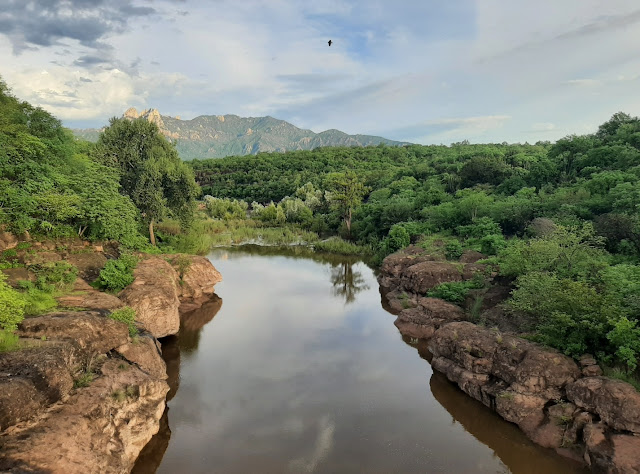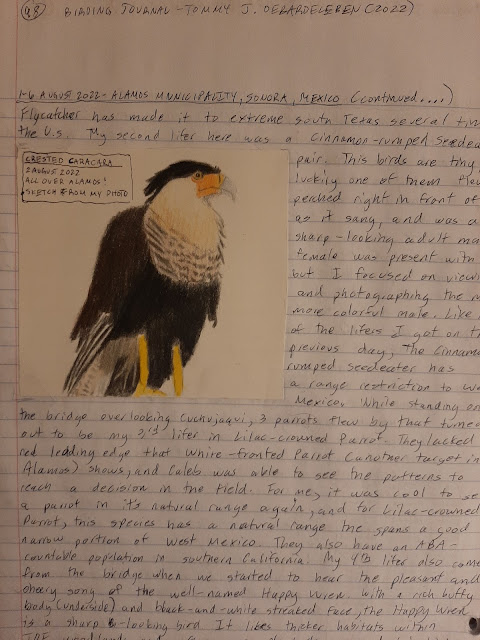For our first full day of birding, we got up early and decided to head to the southeast of town to bird along the Rio Cuchujaqui River via a section/lookout of the river known as Puente. Caleb had it in mind to try for several species here, which did include Purplish-backed Jay and Squirrel Cuckoo, as well as Lesser Roadrunner, Bare-throated Tiger-Heron, or maybe even something on the very scarce side such as a Crane Hawk. The Rio Cuchujaqui was to be a big source of our birding for the trip at several spots of the river, as was Parque La Colorado hiking area, and another area that is called Arroyo Uvalama. The latter is a huge hike into the mountains with tremendous elevation gain and access to Lower and Upper TDF (Thornscrub/Deciduous forest), TDF/oak forest, oak forest, and eventually pine/oak forest. We started off by playing what we should do each day by ear. And on our first full day, we started at Rio Cuchujaqui via Puente.
To get to the Puente overlook, we traveled on a road for about 20 minutes called A El Chinal. A El Chinal traveled through Lower TDF and really had a lot of birds at a few stops that we made. Crested Caracaras lined the road in multiple places, the calls of Sinaloa Crow could be heard, and Elegant Quail ran along the road and eventually into cover. At one stop we made, Black-throated Magpie-Jays were noisy and came into view while harassing a perched Caracara. My lifer (and Scott's too) Purplish-backed Jay called loudly from a valley below us and remained out of sight (I will mention Caleb did a Mexico trip last year and covered Alamos well, and he already had most of the birds we'd be seeing), and it was a bird we were hoping would give us a visual at some point. At one pint where we stopped, we could hear 5 Elegant Trogons vocalizing at once, and it was incredible. And oddly enough, we didn't try to see them as there were many new birds to search for. Other birds present driving in were Mexican Duck flyovers, Sulphur-bellied Flycatcher, Thick-billed Kingbird, Streak-backed Oriole, and Varied Bunting.












Once reaching the Rio Cuchujaqui via Puente, it was
6:41 A.M., and we were treated to incredible views of the river valley as well as the TDF and surrounding mountains. We birded here for over 1.5 hours, and Caleb was really trying to target Lesser Roadrunner, as it is found here with some regularity. We parked by a bridge that went well over the level of the river (about 50 feet or so). Right after parking and starting to bird, Caleb was one out of the three of us who could hear a Squirrel Cuckoo vocalizing down by the river. It was Caleb's first lifer of the trip, and was one we hoped we'd encounter again. It was very birdy at this location and we tallied 54 species (53 for Scott and me). 4 of the 53 species were lifebirds for me and they were: Lilac-crowned Parrot, Social Flycatcher, Cinnamon-rumped Seedeater, and Happy Wren. The Social Flycatcher was my first lifer of the stop, a common species throughout Mexico and further south into much of South America. Social Flycatcher is a small bird that looks somewhat similar to Great Kiskadee, but is easily told apart from that by size and structure. There were a few Kiskadees near 6 different Social Flycatchers to provide comparisons. On another note, Social Flycatcher has made it to extreme south Texas several times in the United States.






My second lifer here was a Cinnamon-rumped Seedeater pair. These birds are tiny, but luckily one of them flew and perched right in front of us as it sang, and was a sharp-looking adult male. A female was present with it, but I focused on viewing and photographing the much more colorful male. Like most of the lifers i got on the previous day, the Cinnamon-rumped Seedeater has a range restriction to West Mexico.



While standing on the bridge overlooking Cuchujaqui, 3 parrots flew by that turned out to be my 3rd lifer in Lilac-crowned Parrot. They lacked the red leading edge that White-fronted Parrot (another target in Alamos) shows, and Caleb was able to see the patterns to reach a decision in the field. For me, it was cool to see a parrot in it's natural range again, and for Lilac-crowned Parrot, this species has a natural range that spans a good narrow portion of west Mexico. They also have an ABA-countable population in southern California. My 4th lifer also came from the bridge when we started to hear the pleasant and cheery song of the well-named Happy Wren. With a rich buffy body (underside) and black-and-white streaked face, the Happy Wren is a sharp-looking bird. It likes thicker habitats within TDF woodlands, and after awhile, this bird came in close to us and gave us some amazing views. Happy Wren is found along western Mexico in it's range, and it is one of those birds that has been found not far south of the Arizona border. It hasn't shown up in the United States yet, but lots of birders believe that it eventually will. Everyone dreams of finding one, myself included. For now, it was great to see it on it's regular range in Alamos.





Alongside the Happy Wren were plentiful Sinaloa and Canyon Wrens. These two wrens sang loudly throughout our stop, and have incredible songs. It was great to get more experience with Sinaloa Wren after seeing a few of them in Arizona and hearing limited vocalizations from them. Other birds present at this Puente overlook included Black-bellied Whistling-Duck, Rufous-bellied Chachalaca, Common Black-Hawk, Ferruginous Pygmy-Owl, Rose-throated Becard, and Varied and Painted Buntings. We did drive down the road further to continue searching for Lesser Roadrunner. Things got exciting when Caleb spotted a Roadrunner and then another Roadrunner, but they both turned out to be Greater Roadrunner. It was kinda funny....
 |
| Greater Roadrunner |
 |
| Rose-throated Becard |
 |
| Great Kiskadee |
 |
| Canyon Wren |
 |
| Varied Bunting |
At another stop further east down the road, we added Rufous-winged Sparrow to the trip list, and the stop also held Elegant Trogon and Ferruginous Pygmy-Owl. From there we went back to the lodge for awhile and then got lunch at a cool restaurant. Green chile enchaladas with chicken (pollo) was my chosen meal, and it was great. The town of Alamos is freaking great! Up next, part two of this first full day at Alamos.
From the Birding Journal:
















































No comments:
Post a Comment